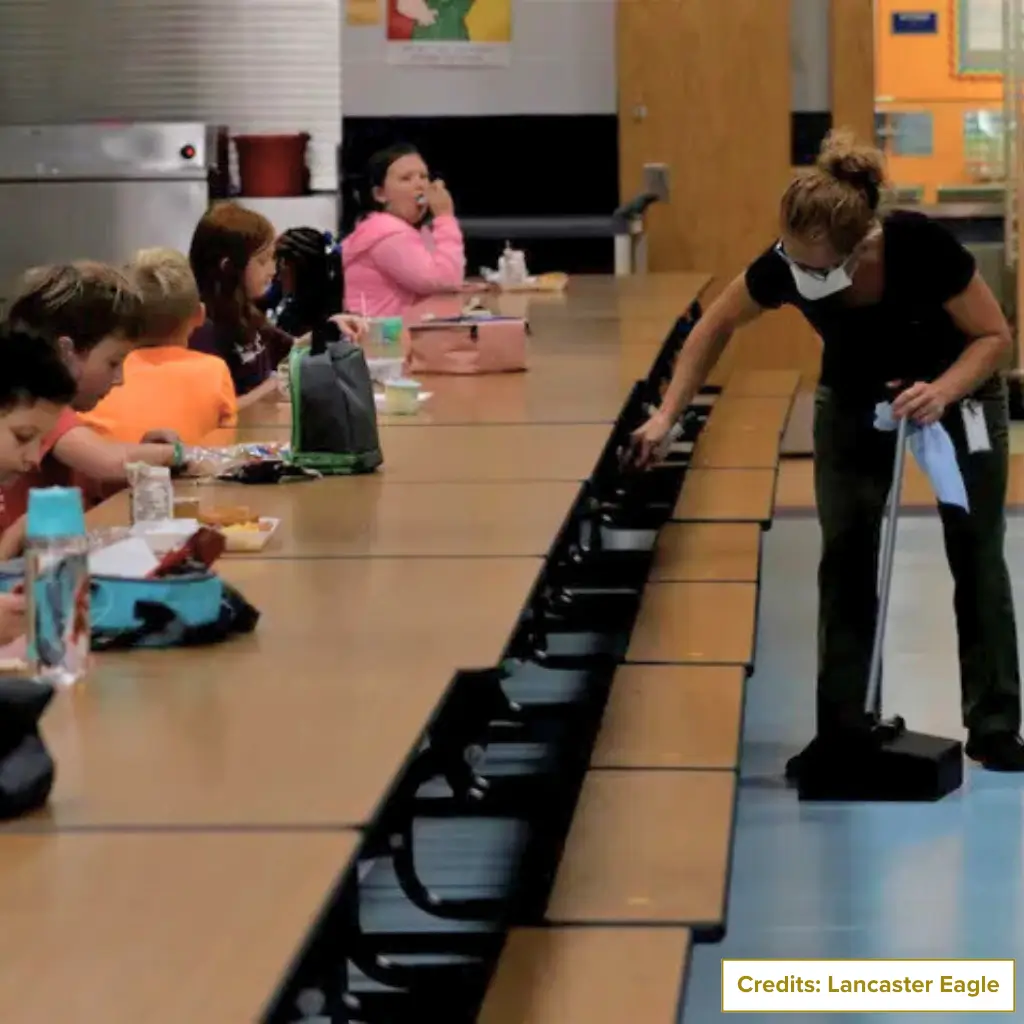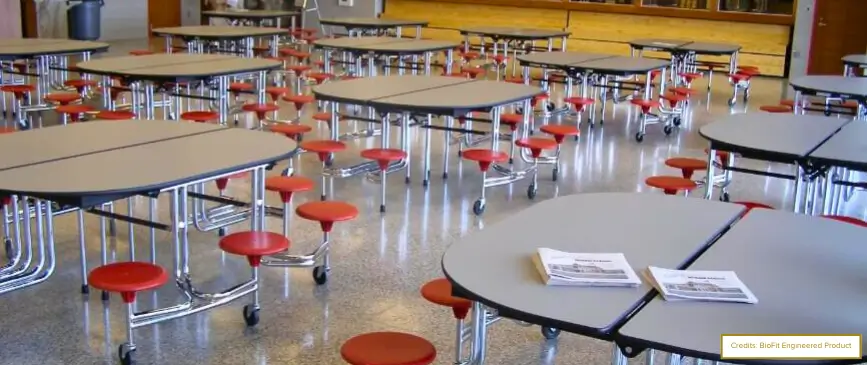Introduction
Have you ever stopped to think about how clean your school cafeteria really is?
We all know it’s the ultimate fun corner where students take a break, grab a bite, and hang out. But let’s be honest: cafeterias are also magnets for spills, crumbs, and yes, germs. Keeping it clean can feel like an endless task, agree?
However, the good news is that u don’t need to do it all on the fly. A well thought out school cafeteria cleanliness checklist can simplify everything. It takes the guesswork out of the equation, keeps you organized, ensures every nook and cranny gets the attention it needs and get the job done faster.
Let’s dive in to explore why cafeteria cleanliness is essential, how to stay on top of it, and an easy-to-follow checklist to keep your cafeteria in tip-top shape.
Why It’s Important to Keep the School Cafeteria Clean?
The importance of a clean cafeteria extends far beyond aesthetics. Think about it: would you enjoy a meal in a cluttered, sticky space? Exactly.
Whether it’s a small school cafeteria or a bustling modern school lunchroom, keeping the space clean is essential for student health, safety, and comfort. Here’s why:
→ Health and Hygiene
An unclean cafeteria can quickly become a breeding ground for germs, bacteria, and viruses. Regular cleaning prevents the spread of illnesses like foodborne infections and the flu, helping to keep students and staff healthy.
→ Student Well-being
A tidy cafeteria fosters an enjoyable eating environment, contributing to students overall happiness. It’s easier for students to socialize and relax in an organized space. Creating such a space can be a cornerstone of building a positive school culture.

→ Safety First
Spills and food debris can cause accidents. From slips to kitchen fires caused by grease buildup, cleanliness minimizes risks, keeping everyone safe.
→ Encouraging Healthy Choices
A clean cafeteria sends a strong message about hygiene and care. This creates an environment where students are more inclined to engage in promote healthy eating, making better food choices for their physical and mental well-being.
→ Compliance with Regulations
Laws like the Food Safety Modernization Act and guidelines from the CDC require schools to meet specific hygiene standards. Regular cleaning not only ensures safety but also keeps schools compliant. avoiding penalties or worse closures.
In short, a clean cafeteria is a win-win. It creates a healthier environment for students and reflects positively on the school as a whole.
Laws and Regulations for Cafeteria Cleanliness
Keeping cafeterias clean isn’t just a recommendation; it’s a requirement. Various laws and standards ensure cafeterias are safe, hygienic, and well-maintained:
-
Food Safety Modernization Act (FSMA)
The FSMA requires schools to follow specific protocols such as regular cleaning schedules and proper food handling to prevent contamination.
-
Local Health Codes
Each region has unique guidelines covering everything from food storage to waste disposal. Staying updated on these codes is essential for compliance.

-
HACCP Principles
Hazard Analysis Critical Control Point (HACCP) systems help schools identify and address potential risks, like cross-contamination or improper food temperatures to maintain cleanliness and safety.
-
OSHA Standards
The Occupational Safety and Health Administration emphasizes staff safety during cleaning, ensuring proper use of tools and chemicals.
-
CDC Guidelines
The Centers for Disease Control and Prevention offers recommendations on handwashing, sanitizing surfaces, and food safety practices, helping schools maintain high standards.
Best Practices to Keep the Cafeteria Clean
Cleaning a cafeteria is more than wiping down tables and sweeping floors. Here are some proven strategies ensure your cafeteria stays spotless:
→ Stick to a Cleaning Schedule
Break down tasks into daily, weekly, and monthly routines. For example, sweeping and wiping down surfaces might be daily chores, while deep-cleaning appliances can be scheduled weekly.
→ Use Safe, Effective Supplies
Opt for non-toxic, food-safe cleaners. Microfiber cloths, disposable wipes, and color-coded tools prevent cross-contamination while making cleaning more efficient.

→ Train Your Team
Equip cafeteria staff with knowledge about proper cleaning techniques, food safety, and handling equipment. Trained employees can better manage a cafeteria’s cleaning needs.
→ Encourage Student Responsibility
Use cafeteria bulletin boards to share tips and reminders about cleanliness. Simple habits like properly disposing of trash can go a long way.
→ Focus on Food Safety
Store food at appropriate temperatures, check expiration dates, and use separate utensils for raw and cooked foods to prevent contamination.
→ Design Thoughtfully
Designing school cafeterias with easy to clean materials, organized storage, and efficient layouts simplifies maintenance and reduces messes.

→ Optimize Seating Arrangements
Assigned seating can help minimize messes and make cleaning quicker. Organized seating also aids in behaviour management, reducing disruptions during meal times.
→ Minimize Food Waste
Implement initiatives that reduce food waste such as composting programs or encouraging students to take only what they’ll eat.
→ Monitor High-Touch Areas
Condiment stations, tray returns, and door handles can quickly accumulate germs. Make it a priority to clean these frequently especially during peak meal hours.
School Cafeteria Cleaning Checklist
The comprehensive school cafeteria cleaning checklist includes:
1. Before Cafeteria Opens (Morning Cleaning)
→ Dining Area
- Sweep and mop the cafeteria floors.
- Wipe down tables, benches, and chairs with a school safe disinfectant.
- Inspect high touch areas (door handles, handrails) and sanitize them.
- Check that all trash bins have liners and are ready for use.
→ Kitchen
- Clean and sanitize countertops, sinks, and prep areas.
- Inspect kitchen equipment (ovens, stoves, fryers, mixers) for cleanliness.
- Check pantry areas and food storage zones for spills and expired items.
- Set up sanitization stations with appropriate cleaning supplies (hand sanitizer, gloves, aprons).
- Ensure dishwashing machines are clean and operational.
- Stock up on dish soap, sponges, and sanitizers.
→ Restrooms (if attached)
- Scrub and disinfect sinks, toilets, and urinals.
- Refill soap, paper towels, and toilet paper dispensers.
- Sweep and mop floors.

2. During Cafeteria Operation (Ongoing Cleaning)
→ Dining Area
- Wipe down tables and benches after each meal session.
- Sweep up crumbs and spills immediately.
- Monitor trash levels and empty bins if full.
- Sanitize high touch surfaces (e.g., tray returns, condiment stations).
→ Kitchen
- Clean prep surfaces between food preparation tasks.
- Monitor cooking equipment for spills or grease build-up.
- Check food holding equipment to ensure food remains at safe temperatures.
→ Restrooms
- Regularly check and clean restrooms during meal times.
- Restock soap, paper towels, and toilet paper as necessary.
- Disinfect points like faucet knobs.

3. After Cafeteria Closes (End of Day Cleaning)
→ Dining Area
- Sweep and mop all floors.
- Wipe and sanitize tables, benches, and chairs thoroughly.
- Inspect walls and floors for stains or marks and spot clean as needed.
- Empty all trash bins and replace liners.
→ Kitchen
- Clean and sanitize all prep areas, cutting boards, and utensils.
- Deep clean stoves, grills, ovens, and fryers.
- Wipe down refrigerators, freezers, and pantry shelves.
- Wash all cookware and ensure they are properly stored.
- Scrub and sanitize sinks and surrounding areas.
- Restock cleaning supplies for the next day.
→ Restrooms
- Clean and sanitize all fixtures (toilets, sinks, mirrors).
- Sweep and mop floors with a disinfectant solution.
- Refill necessary supplies.
→ Trash and Recycling
- Remove all trash and recycling to the designated disposal area.
- Clean and sanitize trash bins thoroughly.
→ General Maintenance
- Inspect for any safety hazards (damaged furniture, broken tiles, etc.).
- Check for proper functioning of equipment, including lights and fans.
- Ensure all windows and doors are locked securely.
4. Weekly/Monthly Deep-Cleaning Tasks
- Dust and clean air vents.
- Inspect and clean light fixtures.
- Check and organize storage and pantry areas.
- Sanitize and defrost freezers and refrigerators.
- Conduct pest control inspections.
- Inspect for cobwebs, grease, or stains and clean as needed.
Conclusion
A clean cafeteria isn’t just a nice to have, IT’s A MUST-HAVE! Whether you’re setting up a high school cafeteria or maintaining an outdoor school cafeteria, a reliable school cafeteria cleanliness checklist ensures your space stays hygienic and welcoming.
By prioritizing cleanliness, you’ll not only meet regulatory standards but also contribute to the impact of school cafeteria on student well-being and academic success.
FAQs
What is a school cafeteria cleaning checklist?
A cleaning checklist is a detailed guide outlining tasks and schedules for cleaning and maintaining a school cafeteria to ensure hygiene and safety.
Who should follow the cafeteria cleaning checklist?
Cafeteria staff, custodians, or janitors are responsible for following the checklist to ensure thorough cleaning and maintenance.
Is it necessary to update the checklist periodically?
Yes, the checklist should be updated as new equipment or regulations are introduced to meet changing needs.


